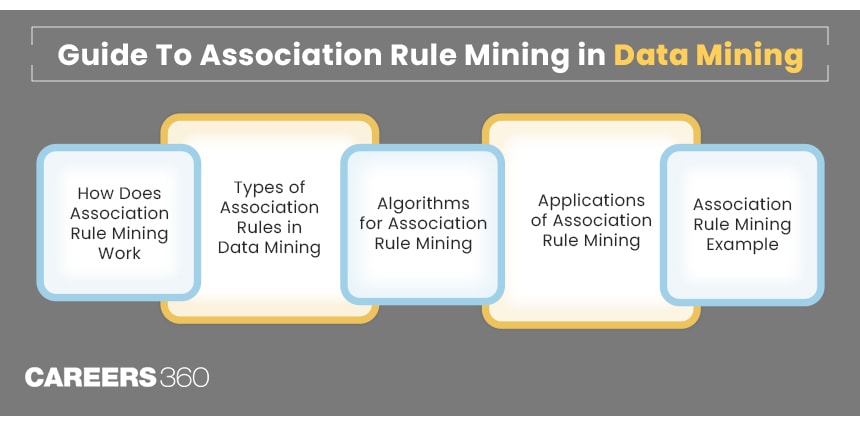BIMTECH PGDM Admissions 2026
AACSB Accredited | Highest CTC: 22 LPA | Last Date: 31st December 2025
In association data mining, Association Rule Mining emerges as a potent force, unravelling intricate patterns and connections within expansive datasets. This article guide seeks to unravel the complexities of Association Rule Data Mining, delving into its profound significance, practical applications, and the algorithms orchestrating its functionality.
This Story also Contains

In a data-driven world, association rule learning becomes paramount, enabling the discovery of meaningful relationships and insights. If you are interested in gaining more knowledge in this field, you can pursue some of the data mining certification courses listed on our website.
Association Rule Mining in data mining is a technique that focuses on discovering interesting relationships, associations, or patterns within large datasets. It aims to unveil connections between variables, helping organisations make informed decisions based on the identified patterns. This process is integral to the broader field of data mining, where the goal is to extract meaningful insights from vast amounts of data.
Also Read:
Association Rule Mining operates on the premise of identifying associations between items in datasets. These associations are often expressed in the form of rules, such as "If A, then B." The strength of these rules is measured by parameters like support and confidence.
Support: Indicates the frequency of occurrence of a particular association in the dataset. It is calculated as the ratio of the number of transactions containing the itemset to the total number of transactions.
Confidence: Measures the likelihood that if item A is present, item B will also be present.It is calculated as the ratio of the support for the combined items in the rule to the support of the antecedent.
1. Frequent Itemset Generation:
Identify sets of items that frequently occur together in the dataset. These sets are known as frequent itemsets.
2. Rule Generation:
Formulate association rules based on the identified frequent itemsets. These rules provide insights into the relationships between different items.
Also Read:
Association rules come in various types, each offering a unique perspective on the data:
Positive Association: Indicates a positive correlation between items, meaning they frequently occur together.
Negative Association: Highlights items that rarely occur together, showing a negative correlation.
Temporal Association: Considers the sequence in which items appear, revealing patterns over time.
Also Read
Several algorithms drive the process of Association Rule Mining. Some notable ones include:
Apriori Algorithm: A classic algorithm that iteratively identifies frequent itemsets.
FP-Growth Algorithm: Employs a divide-and-conquer strategy for efficient frequent itemset discovery.
Eclat Algorithm: Focuses on vertical data format, simplifying the process of finding frequent itemsets.
Also Read: Free Data Mining Courses & Certifications
The versatility of Association Rule Mining makes it applicable in various domains:
Retail and Market Basket Analysis: Identifying patterns in customer purchasing behaviour to optimise product placement and promotions.
Healthcare: Analysing patient records to discover associations between symptoms and medical conditions.
E-Commerce: Personalising recommendations based on the browsing and purchasing history of users.
Fraud Detection: Uncovering patterns indicative of fraudulent activities within financial transactions.
Consider a retail scenario where Association Rule Mining is applied to a customer transaction dataset. The process might reveal a rule like:
"If a customer purchases diapers, there is a 70% chance they will also buy baby wipes."
This rule, derived from the data, can inform marketing strategies and product placement in the store.
Related: Data Mining Certification Courses by Top Providers
In conclusion, Association Rule Mining is a formidable tool in the data mining arsenal, providing valuable insights into relationships within datasets. Its applications span various industries, offering actionable intelligence for decision-makers. By understanding the principles, types, and algorithms behind Association Rule Mining, organisations can harness its power to make informed decisions and uncover hidden patterns in the data.
Frequently Asked Questions (FAQs)
Certainly. In retail, if customers frequently purchase sunscreen and beach towels together, a rule could be generated: "If a customer buys sunscreen, there is a high likelihood they will also purchase beach towels." This insight can guide product placement and marketing strategies.
Notable algorithms include Apriori, FP-Growth, and Eclat. Apriori iteratively identifies frequent itemsets, FP-Growth employs a divide-and-conquer approach, and Eclat focuses on a vertical data format for efficient itemset discovery.
Association Rule Mining is a data mining technique focusing on discovering meaningful relationships or patterns within large datasets. It works by identifying frequent itemsets and generating rules that express associations between different items.
Association Rule Mining is crucial as it uncovers hidden patterns, enabling organisations to make informed decisions. By revealing associations between variables, it provides valuable insights for optimising processes and strategies.
Association Rules come in positive, negative, and temporal types. Positive rules show a frequent co-occurrence, negative rules reveal rare associations, and temporal rules consider the sequence of events over time.
Among top 100 Universities Globally in the Times Higher Education (THE) Interdisciplinary Science Rankings 2026
National level exam conducted by VIT University, Vellore | Ranked #16 by NIRF for Engg. | NAAC A++ Accredited
Among top 100 Universities Globally in the Times Higher Education (THE) Interdisciplinary Science Rankings 2026
Ranked among top 10 B-Schools in India by multiple publications | Top Recruiters-Google, MicKinsey, Amazon, BCG & many more.
Among top 100 Universities Globally in the Times Higher Education (THE) Interdisciplinary Science Rankings 2026
Globally Recognized by AACSB (US) & AMBA (UK) | 17.8 LPA Avg. CTC for PGPM 2025